



Cézanne and the Steam Railway (6)
: A Style Anlysis on His Painted Representaitons
Tomoki Akimaru (Art Historian)
Below is an abstract of my doctoral dissertation.
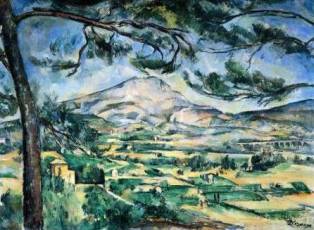 Fig. 1 Paul Cézanne The Mont Sainte-Victoire and Large Pine c. 1887 |
Fig. 2 A photograph of the scene in Fig. 1, photographed by the author on August 24, 2006. |
|
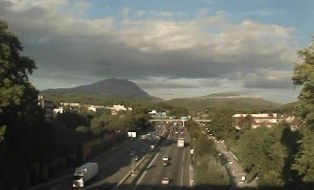 Fig. 3 The Mont Sainte-Victoire seen from the train while passing through the railway bridge at the Arc valley (photographed by the author on August 26, 2006) |
Fig. 4 The Mont Sainte-Victoire seen from the train while passing through the railway bridge at the Arc valley (filmed by the author on August 26, 2006) |
We will now discuss more concretely the influence of the transformed visual perception induced by the passing sceneries seen from a moving train on Cézanne’s painted representations.
First, let’s review the features of scenery when viewed from a moving train.
Gyorgy Kepes wrote about this in his Language of Vision (1944) that, “From a moving train, the closer the object the faster it seems to move. A faraway object moves slowly and one very remote appears to be stationary” (1).
Thus, from a train window, objects at a distance appear to move slowly while those that are near appear to move quickly and horizontally.
Moreover, Wolfgang Schivelbusch explained in his Railway Journey (1977) that “there the depth perception of pre-industrial consciousness was, literally, lost: velocity blurs all foreground objects, which means that there no longer is a foreground—exactly the range in which most of the experience of preindustrial travel was located... [T]he train’s speed separated the traveler from the space that he had previously been a part of. As the traveler stepped out of that space, it became a stage setting, or a series of such pictures or scenes created by the continuously changing perspective” (2).
In short, from a train window, the nearest elements of the scenery pass at such high speeds that they seem to disappear, which is experienced as a loss of the whole foreground. Thus, any traveler who has grasped a sense of distance with scenery as a continuous extension of his body will be alienated from the landscape and will appreciate a screen that has turned this loss of depth into a spectacle as a comfortable form of leisure.
One of Cézanne’s works that duplicate the visual features of train window scenery in a particularly striking manner is The Mont Sainte-Victoire and large Pine (c. 1887) (Fig. 1-Fig. 4).
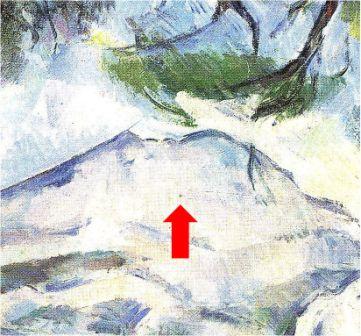
Fig. 5 The expansion part of Fig. 1
Interestingly, in this painting, a central point is drawn on the center of the Mont Sainte-Victoire (Fig. 5). From this central point to the nearby pine branches, the brush strokes tend to be repeated in the transverse direction and gradually become coarse. We may therefore suppose that Cézanne used this central point to depict the manner in which nearby objects fly away quickly in the horizontal direction when perceived from a moving train.
Moreover, since the trunk of the nearby pine on the left disappears under the canvas while it remains strangely thin, it is difficult to perceive the lower space under the screen. We certainly cannot assume that this pine exists on the same ground level that spreads from the mountain to the plain. The observer thus seems to be looking at this landscape from above.
In relation to this, the small white brushstroke drawn between the Mont Sainte-Victoire and the branch of pine on it renders the spatial relationship between the mountain and the branch very ambiguous (Fig. 4).
Moreover, the ambiguity of the depth perception is intensified by the fact that the branches on the near right and ridgeline of the mountain do not overlap (even the bottom branch seems to cast a shadow over the mountain) and the branches on the near left seem to be parallel to the screen.
These artistic expressions replicating the view from a moving train can be defined as a “nearer-roughening of touch,” “side-repeating of stroke,” “disappearing of foreground,” and “flattening of picture.” These characteristics become even clearer through comparison with Cézanne’s other works.
Fig. 6 Paul Cézanne The Mont Sainte-Victoire 1902–1906 |
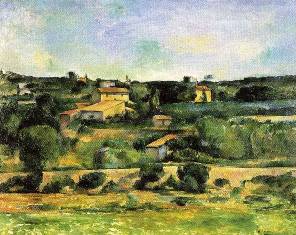 Fig. 9 Paul Cézanne In the Bellevue plain 1885-1888 |
|
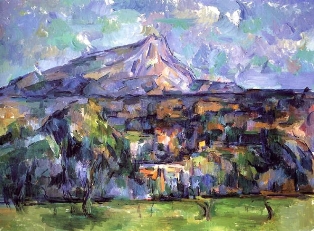 Fig. 7 Paul Cézanne The Mont Sainte-Victoire Seen from Les Lauves 1902-1906 |
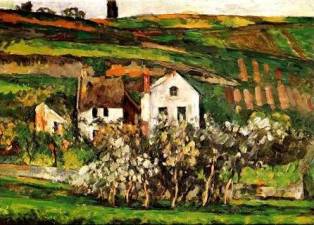 Fig. 10 Paul Cézanne Small Houses at Auvers-sur-Oise 1873-1874 |
|
Fig. 8 Paul Cézanne The Mont Sainte-Victoire Seen from Les Lauves 1904-1906 |
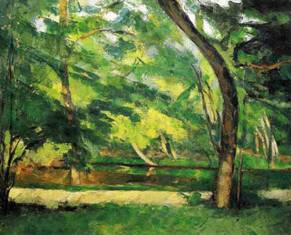 Fig. 11 Paul Cézanne The Etang des Soeurs, Osny, near Pontoise 1877 |
For example, comparing The Mont Sainte-Victoire (1902–1906) (Fig. 6), The Mont Sainte-Victoire Seen from Les Lauves (1902-1906) (Fig. 7), The Mont Sainte-Victoire Seen from Les Lauves (1904–1906) (Fig. 8), In the Bellevue plain (1885-1888) (Fig. 9), Small Houses at Auvers-sur-Oise (1873-1874) (Fig. 10), and The Etang des Soeurs, Osny, near Pontoise (1877) (Fig. 11), we notice that the brushstrokes are gradually repeated in the transverse direction and the images of the closer objects appear rougher. In the nearest view, they turn into an almost oblong color belt, and the whole foreground seems lost.
Thus, the continuity between the observer and the scenery weakens, and the observer seems to look at these landscapes while hovering in the air. Furthermore, because the ridgelines of the ground form high layers, the whole screen appears to lose depth.
In addition, Jules Clarétie characterized the view from a speeding train in his Voyages d'un parisien (1865) as follows:
In a few hours, (the railway) shows you all of France, and before your eyes it unrolls its infinite panorama, a vast succession of charming tableaux, of novel surprises. Of a landscape it shows you only the great outlines, being an artist versed in the ways of the masters. Don't ask it for details, but for the living whole (3).Relevantly, in a letter to Émile Bernard dated April 15, 1904, Cézanne commented on his famous painting theory as follows:
May I repeat what I told you here: treat nature by means of the cylinder, the sphere, the cone, everything brought into proper perspective so that each side of an object or a plane is directed towards a central point (4).We saw in chapter 1 that the bridge drawn in the center right of Fig. 1 is a railway bridge (Fig. 12, Fig. 13) and that Cézanne praised the Mont Sainte-Victoire while viewing it from a train passing over this bridge, saying in his letter to Émile Zola dated April 14, 1878, “quel beau motif (what a beautiful motif)” (5).
Therefore, the possibility that the transformation of visual perception induced by the steam railway is reflected in Cézanne’s painted representations is undeniable.
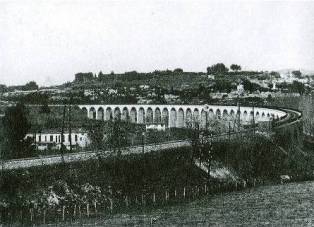 Fig. 12 The railway bridge at the Arc valley around 1903 (Photographer unknown) |
Fig. 13 The railway bridge at the Arc valley (photographed by the author on August 22, 2006) |
(1) Gyorgy Kepes, Language of Vision, Chicago: Paul Theobald, 1944; New York: Dover Publications, 1995, p. 171.
(2) Wolfgang Schivelbusch, Geschichte der Eisenbahnreise: Zur Industrialisierung von Raum und Zeit im 19. Jahrhundert, München: Carl Hanser, 1977; Frankfurt am Main: Fischer Taschenbuch, 2004, p. 61. (Wolfgang Schivelbusch, The Railway Journey: The Industrialization of Time and Space in the 19th Century, Berkeley and Los Angeles: The University of California Press, 1986, pp. 63-64.)
(3) Cited in Ibid., p. 59. (Ibid., p. 61.)
(4) Paul Cézanne, Correspondance, recueillie, annotée et préfacée par John Rewald, Paris: Bernard Grasset, 1937; nouvelle édition révisée et augmentée, Paris: Bernard Grasset, 1978, p. 300. (Paul Cezanne, Letters, edited by John Rewald, translated from the French by Marguerite Kay, New York: Da Capo Press, 1995, p. 301.)
(5) Ibid., p. 165. (cf. Ibid., p. 159.)
(Fig. 12 was quated from John Rewald, Cezanne: A Biography, New York: Harry N. Abrams, 1986.)
This is a revised edition of “New Viewpoint on Art: Cézanne and Steam Railway (4)” published in Nihon Art Journal, July/August, 2012.
Copyright (C) Tomoki Akimaru.All rights reserved.